The History of the Rolex GMT-Master and GMT-Master II, the Iconic Traveller’s Watch
It might not be the first-ever GMT watch, but it is arguably the genre’s defining model.
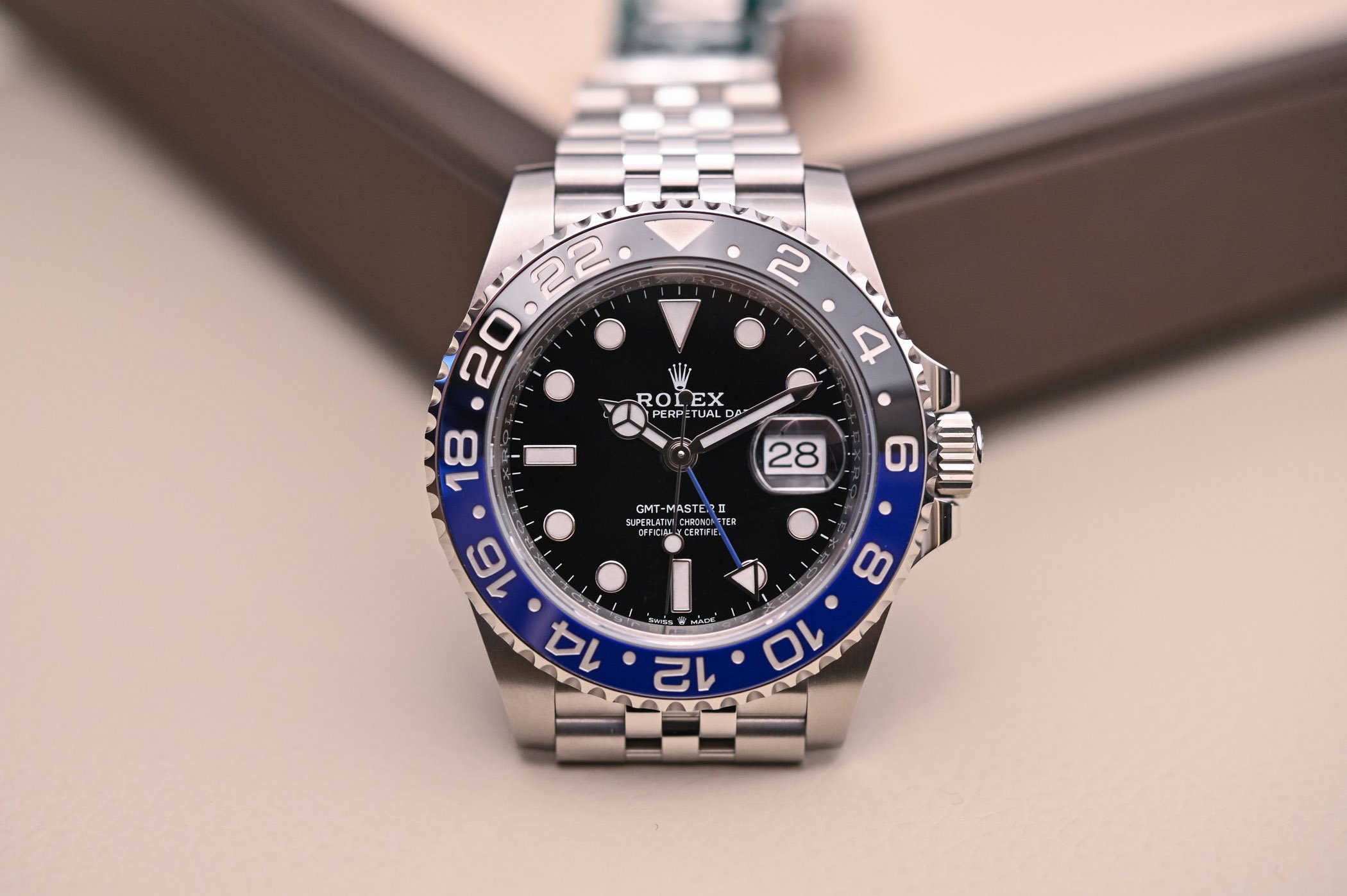
The Rolex Submariner is among the most iconic watches of the brand’s entire portfolio and even the choice of James Bond (in the earlier years, at least), but the GMT-Master series is up there in popularity as well, and arguably the most iconic traveller’s watch from any brand. It lived alongside the Explorer II models that also had GMT functionality (although not at first), and they even shared calibres. But the addition of a rotating bezel and later an independently-set local hour hand set the Rolex GMT-Master series apart. There are two main designations, the GMT-Master and GMT-Master II, which differ in functionality but are otherwise similar aesthetically. They were available simultaneously for 16 years in the 1980s and 1990s, but the GMT-Master II is now the lone model and one of the best ambassadors of Rolex history.
The Rolex GMT-Master (not yet II)
The original GMT-Master (ref. 6542) officially debuted in 1955 and was made in partnership with Pan Am Airlines. It was designed for pilots who were consistently flying through multiple time zones, coinciding with the advent of commercial aviation. As an example below, the watch worn by Captain Clarence Warren when piloting the non-stop New York to Moscow flight in 1958 – images below by www.sothebys.com.
The Rolex GMT-Master quickly became popular with US Air Force pilots and civilian counterparts, and even NASA astronauts. One was on the wrist of Jack Swigert during the harrowing Apollo 13 mission, and another one by Stuart A. Roosa during the Apollo 14 mission – the actual watches can be seen here.

But now, let’s take a look at the different references of the original GMT-Master line that truly defined the traveller’s pilot watch.
GMT-Master Ref. 6542 (1955 – 1959)
There’s a bit of confusion as to whether the original GMT-Master debuted in 1954 or 1955, but we’ll stick with what Rolex currently has listed in their timeline and go with 1955. The first model was 38mm in diameter with an Oyster Perpetual case and featured a bakelite (early plastic) bidirectional rotating bezel with radium numerals for the 24-hour scale. It was half red, half blue in a “Pepsi” style that acted as a day/night indicator – red for day, blue for night. Nine years later, in 1964, Honor Blackman wore the model in Goldfinger, so it became known as the “Pussy Galore” model. The Submariner didn’t steal all of the James Bond glory. There was a date at 3 o’clock with a Cyclops lens, borrowing from the recent Datejust design, and the crystals were acrylic at the time.

As is always the case, there were small variations within reference numbers and 6542 models had small(ish) lume indices and briefly moved to larger ones in 1958 before returning to the smaller aesthetic. All steel models had glossy black gilt dials with Mercedes hands and a red 24-hour hand with a small lume triangle. There were subtle variations in lume placement, printing, case beveling and so on, but a bit too numerous to specify here. The bakelite bezel inserts were controversial for two reasons – they didn’t age well, they tended to crack, and they were radioactive from radium, resulting in a US cancer lawsuit and ultimate recall of early models. Consequently, original bakelite models are very rare and expensive today as many were converted to anodized aluminium bezel inserts. The lawsuit occurred in 1961, so this happened after the reference ceased production in 1959.

While the steel models had Pepsi bezels, 18k gold models all had brown bezels, along with alpha hands instead of Mercedes on brownish/gold or lighter champagne dials. The indices were applied in gold with small radium inserts in the centre, and became known as nipple markers. Powering both steel and gold models was the chronometer-rated calibre 1065, based on the calibre 1030 with the addition of a 24-hour hand. Minor upgrades with this first reference included calibres 1065 and 1066 from 1957 to 1959.
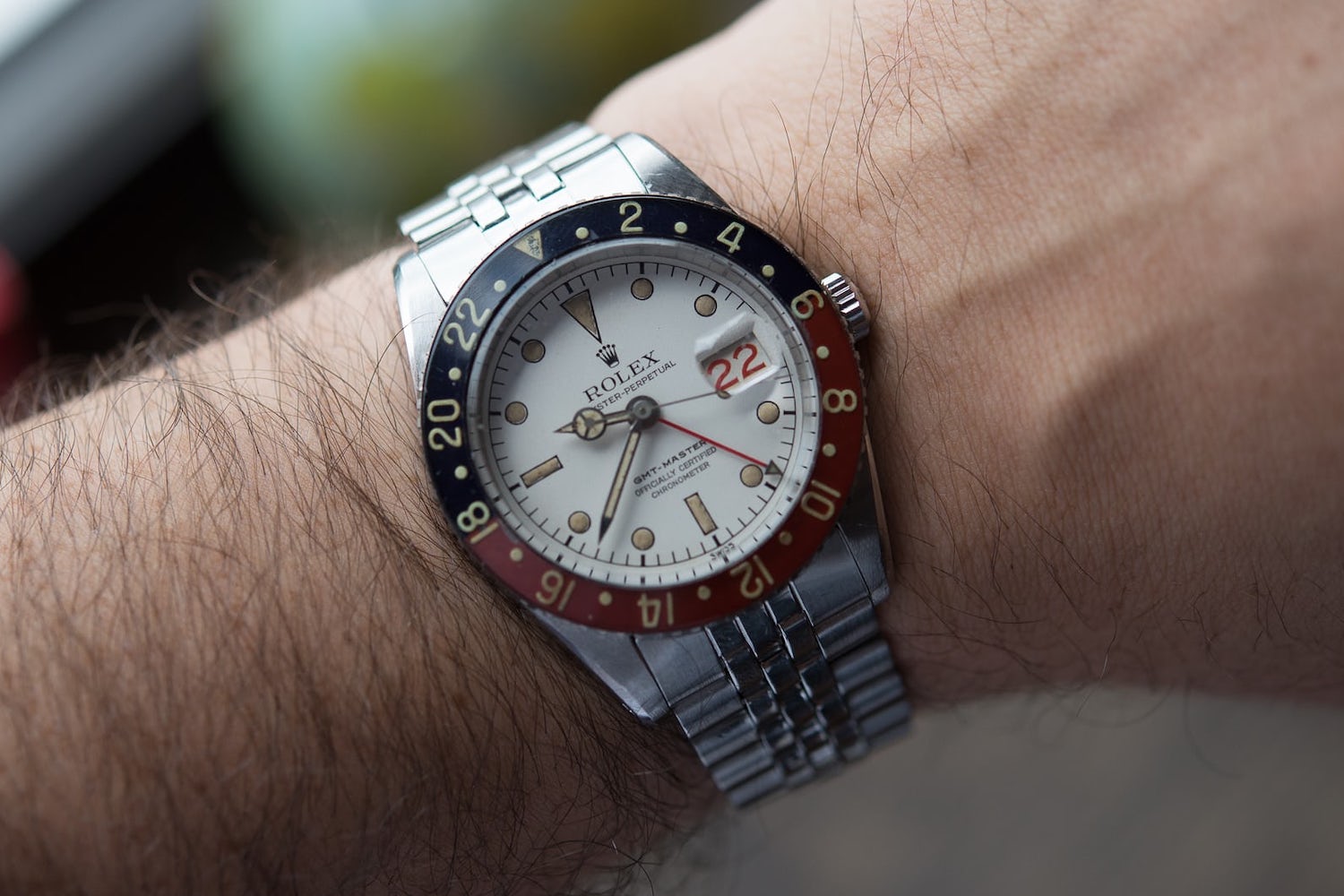
Interestingly, a steel model with a white or “Albino” dial exists, but is exceptionally rare and certainly not the norm within this reference. After a professional breakdown and inspection of a known example, it was determined to be original. So, how many were made? Your guess is as good as mine – perhaps only a few or maybe even one. Regardless of colour, all were “OCC dials” with OFFICIALLY CERTIFIED CHRONOMETER printed beneath GMT-MASTER, which would continue into the next reference.
GMT-Master Ref. 1675 (1959 – 1980)
The second reference that ran for over 20 years is the GMT-Master 1675, making it the longest-running reference of any GMT-Master. There are two dial variances within this reference – glossy gilt and matte black, with the latter first appearing around 1966. Early ref. 1675 bezels also had thicker fonts, making them prized by collectors today. Gone were the bakelite bezel inserts in favour of anodized aluminium, mirroring the replacements found in earlier 6542 models that were recalled. These were again Pepsi variants that tended to fade over time, so colours are often much lighter today.
The biggest physical changes were a case size increase to 40mm and the addition of crown guards, which made it similar in appearance to the Submariner. However, crown guards were only on the steel models, as the 18k gold cases remained unguarded (at least in the first years of production).
Starting around 1960, OCC dials changed to SUPERLATIVE CHRONOMETER OFFICIALLY CERTIFIED dials, which meant the movement was upgraded to the microstella-regulated calibre 1565 over the earlier calibre 1535. Microstella-regulation is the precise adjustment of screws on the balance wheel. The early dials also had closed chapter rings (a perimeter ring with minute/seconds marks), which later changed to marks without an attached ring or “open chapter.”
In 1962, a small spot of lume was placed under the 6 o’clock index, creating an exclamation point that hadn’t been seen earlier. It supposedly signified a less radioactive variant of radium or the early use of tritium (or perhaps a combination of the two). It wasn’t until 1964 that the addition of a “T” officially signified the use of tritium. The exclamation point has been used on other Rolex dials as well, including the Explorer and Submariner, for the same purpose. In 1963, the aforementioned closed chapter ring was deleted in favour of longer minutes/seconds marks that reached the dial edge. The exclamation point index disappeared with this open chapter and was only seen on earlier models with closed chapter rings. 1963 was an interesting year for GMT Master dials as SWISS was also printed twice at the bottom (one over the other), and an underline appeared below SUPERLATIVE CHRONOMETER OFFICIALLY CERTIFIED.
Heading into 1964, the dials have SWISS, T < 25 printed below the 6 o’clock index to signify the use of tritium that emits less than 925 MBq. It’s unclear if this is different from some dials with the exclamation point index. Crown guards had changed a bit as well with a “broad pointed” design, although this varied depending on the reference.
Ref. 1675 in 18k Gold
As mentioned, the early gold 1675s didn’t have crown guards, and the dials and bezel inserts were the same (aesthetically) as the earlier gold ref. 6542 models. These became known as Concorde GMT Masters as they were featured in advertisements in the late 1960s and 1970s on the wrists of Concorde pilots. Later models did get crown guards, but generally stuck with alpha hands, and the minute hand became thinner, while the 24-hour hand had a bigger triangle. Anomalies include Mercedes or even baton hands (so-called Concorde models) sporadically seen on 1675 gold dials (crown guards or no crown guards), and some even got a black dial with an all-black bezel insert.

Ref. 1675 Two-Tone “Root Beer” Model
The two-tone or Rolesor variant was very popular and continued into the next reference with a day/night bezel insert in brown and yellow-ish gold (hence Root Beer). It had the applied nipple markers of the previous 18k gold dials and included Mercedes hands and an applied gold Rolex coronet. It’s unofficially known as the Clint Eastwood GMT Master, as he not only owned one but wore it in several movies.
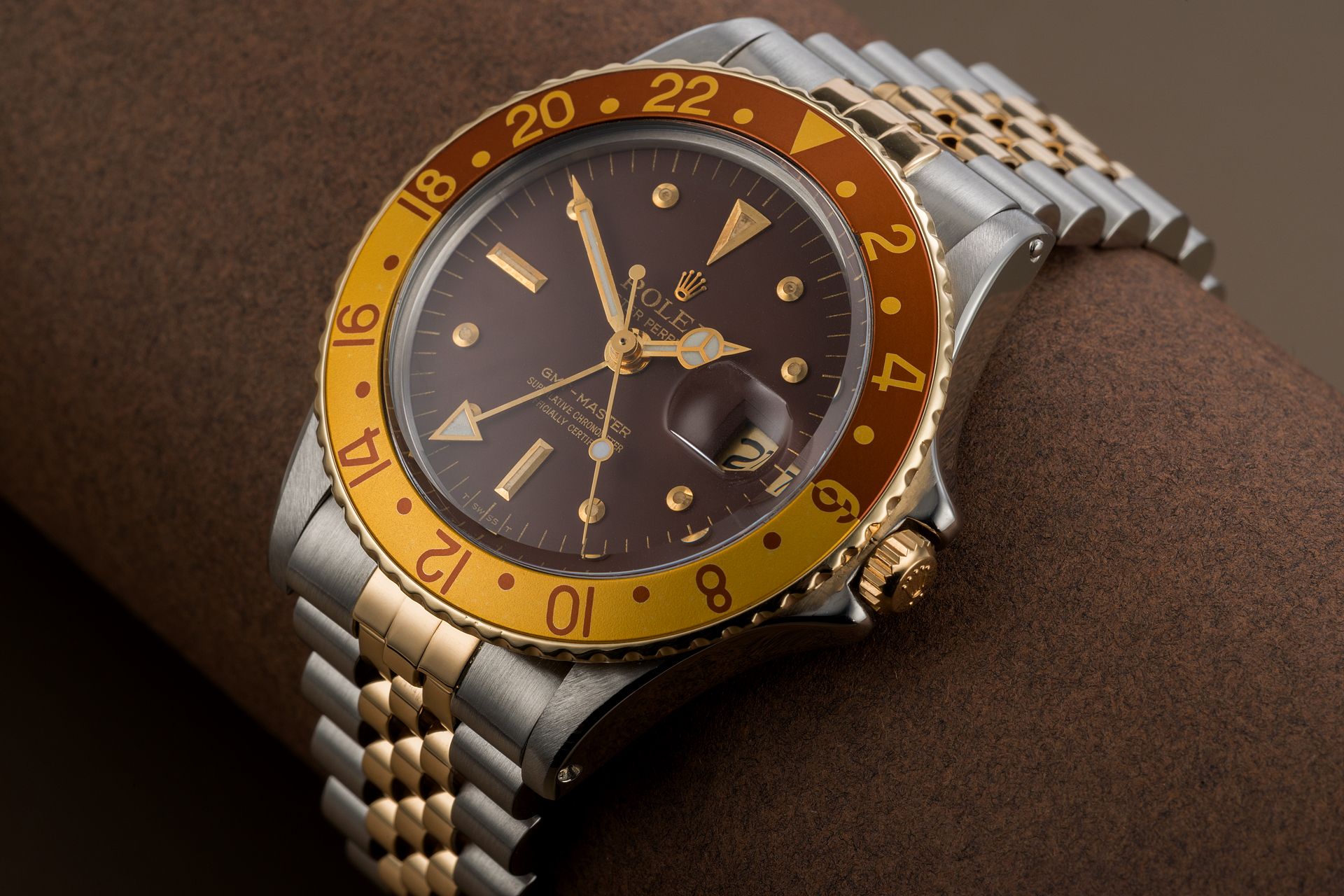
GMT-Master Ref. 16750 (1980 – 1988)
Following the longest run of a GMT-Master reference, we have the 16750, which introduces a quick-set date using the new calibre 3075. This movement also brought the beat rate to a contemporary 28,800vph compared to 19,600vph on the 1675 models. A quick-set date allowed the date wheel to be set with the crown at the first position instead of the hour hand having to make two full rotations per advance. The case also increased its water-resistance rating to 100m from 50m. This reference set the stage for the GMT Master II that would launch a couple of years later and was a significant upgrade for the series.

The initial 16750s continued with the matte dials of the 1675, but that changed to glossy lacquer and white gold indices. Unfortunately, many lacquer dials suffered the same fate as the early bakelite bezel inserts – they were prone to cracking and earned the nickname “spider dials” for the hairline cracks that often developed. Although not meaningful in practice, the central hands also changed their stacking order, with the 24-hour hand moving up from the bottom, going above the hour hand.
18k Gold 16750 Variant – Ref. 16758
The 18k gold variant got its own reference number but is ultimately the gold 16750. Dials evolved from the traditional nipple indices to later flat ones with gold surrounds. A sapphire crystal also replaced acrylic for the first time, but the steel 16750s maintained the older crystals. Most had black dials with black bezel inserts, although some came with brown dials and bezel inserts (not unlike the earlier gold 1675 Concorde models).

GMT-Master Ref. 16700 (1988 – 1999)
This last GMT-Master and the previous 16750 were produced alongside the GMT-Master II, which launched in 1982 (more on that below). What’s interesting is that we had an additional reference debut during GMT Master II production instead of the 16750 simply finishing its production run and letting the sequel fully take over. Rolex continued to develop the original series as a more cost-effective option. Another interesting quirk is that ref. 16700 came after ref. 16750. Rolex just does its thing.

The last movement for the GMT Master was calibre 3175, and little else changed other than tritium being replaced by Super-LumiNova in 1997 near the end of its production (skipping LumiNova altogether). Calibre 3175 didn’t change the dynamic of the GMT-Master since its launch in 1955. The local hour and 24-hour hands were always synched together, requiring the rotation of the 24-hour bezel to track a second time zone via the fourth 24-hour hand. This was the same as early Rolex Explorer II models, but those had fixed bezels that didn’t allow for an additional time zone. Its fourth hand was strictly a day/night indicator until the new calibre 3085 freed the bond between the Explorer II hour hands in 1985. However, the GMT-Master II got this movement three years earlier.

The Evolution, the GMT-Master II Ref. 16760 (1982 – 1988)
The GMT-Master II started with ref. 16760 and again lived alongside the GMT-Master ref. 16750 in 1982. The new calibre 3085 changed the game by allowing the local hour hand to be set separately from the 24-hour hand in one-hour increments. The tracking of a third time zone was now possible and a major upgrade from the GMT-Master. The case became thicker to accommodate the movement upgrade, so it became known as the “Fat Lady” model. The familiar Pepsi bezel was joined by a “Coke” variant that was red and black – red for day, black for night. Other than this Pepsi challenge and thicker case, the first GMT-Master II was similar aesthetically to the GMT Master, with the new bezel insert being the most obvious change.

GMT-Master II Ref. 16710 (1989 – 2007)
The second GMT-Master II had the longest run for a Master II reference and brought an all-black bezel insert to join Pepsi and Coke. This was the last GMT Master II to live alongside a new GMT Master (ref. 16700) that was phased out in 1999. An upgraded movement, calibre 3185, allowed the case to slim down and shed the “Fat Lady” nickname. In the last year of production in 2007, a handful got the upgraded calibre 3186 with a Parachrom hairspring for better temperature and shock resistance. Some of these very late 16710 models also had an “error dial” that’s rare and a collector’s dream. Also known as a “stick dial,” the II in GMT Master II above 6 o’clock didn’t have horizontal line caps as otherwise seen. Subtle but very valuable today.

From 1989 to 1997, the dials used tritium with the SWISS – T<25 designation printed below 6 o’clock. Subsequent models switched to LumiNova until 1999 and then Super-LumiNova. Of course, T<25 was removed from the dial. Drilled lugs were removed in 2003, requiring the spring bars to now be removed from the inside face of the lugs, and the bracelets themselves got solid end links in 2000. In 2005, Rolex celebrated the 50th anniversary of the GMT Master series with an updated, bolder case (lugs primarily) in 18k gold with an all-black ceramic bezel. Ceramic bezel inserts would replace aluminium entirely in the next reference.
GMT-Master II Ref. 116710LN (2007 – 2019)
This reference had a substantial run and introduced the Cerachrom bezel as a permanent update, which is a fancy word for ceramic. Unlike the 2005 gold 116718LN, these came in steel and featured the same all-black bezel inserts, and calibre 3186 seen in a handful of late 16710 models was now standard. A new two-tone steel and 18k gold Rolesor variant with the black bezel emerged as ref. 116713LN, while Super-LumiNova was soon replaced with Rolex’s own Chromalight display with a blue glow. With the switch to Cerachrom bezel inserts, the popular and traditional Coke and Pepsi aesthetic was discontinued. As with the Ford Model T, you could get a bezel in any colour as long as it was black. The 24-hour hand initially became green along with GMT-MASTER II above 6 o’clock. Fortunately, Batman left his cave in 2013 (see below), and dual (day/night) colours returned to the bezel inserts.

GMT-Master II Ref. 116710BLNR Batman (2013 – 2019)
The ceramic “Batman” bezel inserts weren’t initially easy to produce in dual colours and required a patented process. An all-blue porous ceramic insert had black added to the top half. It was the first GMT Master to have this colour combo, regardless of bezel insert material, and was a smash hit from the start. The 24-hour hand became a matching blue as well as ref. 116710LN and offshoots seemed to play with colour on the hands and dials more than prior models.

To keep things consistent, I’m going to briefly jump to the next major reference with another Batman model, ref. 126710BLNR (2019 – present day). It’s aesthetically the same watch, but now on a Jubilee bracelet with a huge movement upgrade thanks to the calibre 3285 and Chronergy escapement (more on that below under ref. 126710BLRO). Only the GMT Master II has a Batman bezel within all of Rolex’s portfolio, making it a unique model for sure.

GMT-Master II Pepsi 116719BLRO (2014 – 2018)
Once Rolex had perfected dual colours on the Cerachrom bezels, the familiar Pepsi bezel returned in 2014, a year after Batman. There was an unfortunate catch as only newly introduced 18k white gold models got the Pepsi bezels. You initially had to pay to play for the iconic look. White gold was a first for the GMT Master series, and it’s believed this was done as producing red on ceramic bezels was still a difficult process, so the much higher price of solid gold limited demand (so production could keep up). In 2018 (in the next reference), Rolex finally released a steel Pepsi model as they grew comfortable with ceramic/red production, while the white gold variants shifted to a blue dial instead of black. If previous white gold buyers were upset, Rolex even offered a dial swap to blue. To this day, all white gold Master GMT II models now have blue dials, identified as ref. 126719BLRO.
GMT-Master II Ref. 126715CHNR (2018 – present)
Several GMT Master II variants emerged in 2018, notably an 18k gold Everose (rose gold) model, ref. 126715CHNR, to join the white gold variant from 2014. It had a black and brown Cerachrom bezel and a black dial. An additional two-tone Rolesor model came with a Root Beer bezel and dial, ref. 126711CHNR, which brought back the fan-favourite aesthetic going back decades to ref. 1675.
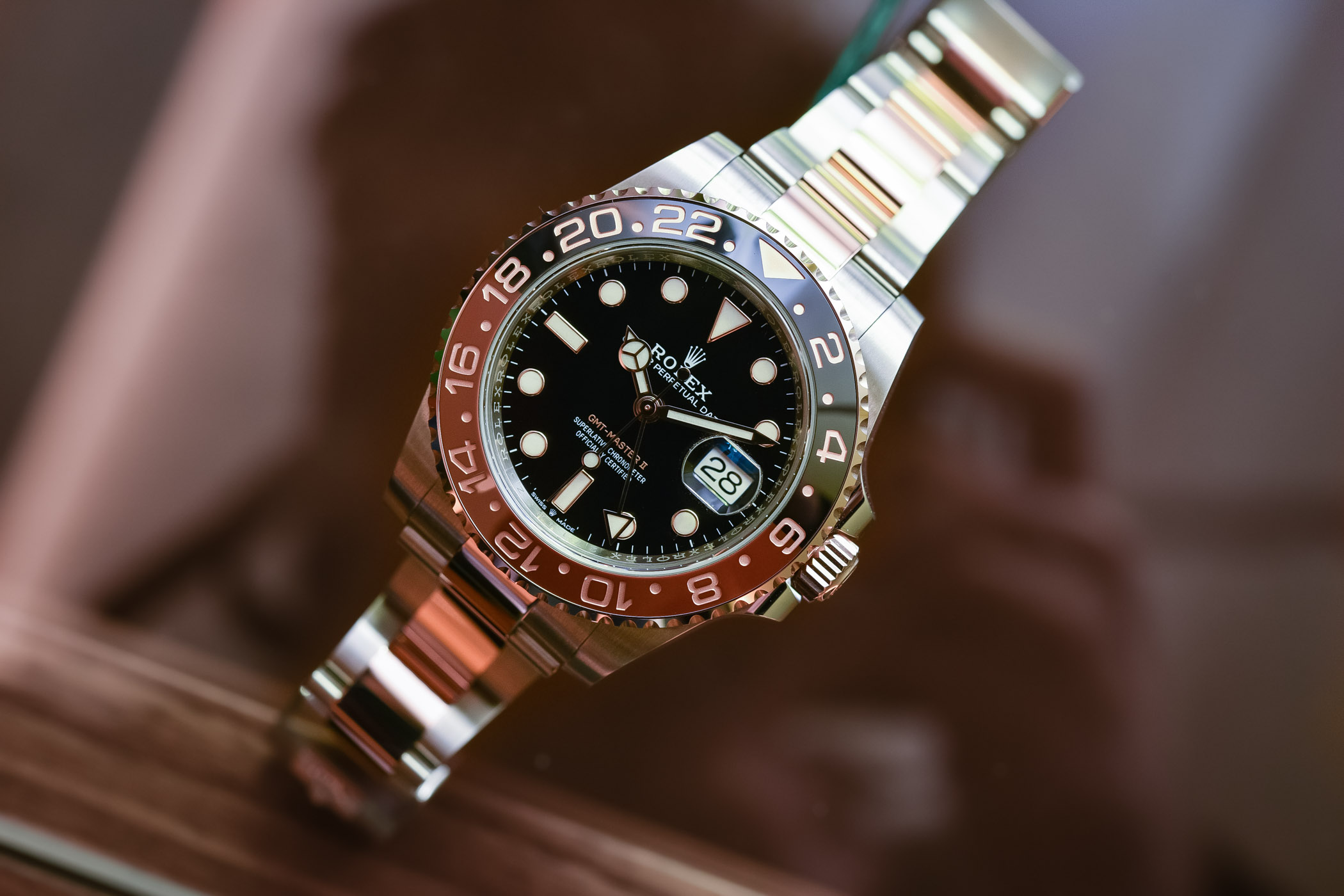
GMT-Master II Ref. 126710BLRO Pepsi (2018 – present)
The steel Pepsi model was again here to stay, now on a Jubilee bracelet with the classic black dial and red 24-hour hand. The addition of an Oysterlock clasp to the bracelet allowed for 5mm of tool-free adjustments in 1mm increments. Calibre 3285 was introduced in 2018 with significant improvements. The power reserve went to 70 hours from 50, and more importantly, Rolex’s newly designed Chronergy escapement debuted with modifications to the lever escapement. Overall efficiency improved by 15% with lighter components and redesigned escape wheel teeth and pallet stones. Anti-magnetic nickel-phosphorus was also used for the escapement. Accuracy improved to an astounding +/- 2 seconds per day, redefining the brand’s “Superlative Chronometer” designation.
This latest stainless steel Pepsi model has become one of Rolex’s most popular models ever and a must-have piece for modern collectors, although vintage Pepsi models certainly rival that desirability. It comes full circle with the classic design from the 1950s married to the latest technology, inside and out. Unfortunately, you’ll likely never find one at retail as they’re among the hardest of all Rolex models to officially acquire.
GMT-Master II Ref. 126720VTNR Sprite (2022 – present)
Probably one of the most surprising and most controversial watches released by Rolex in years, the brand introduced the steel reference 126720VTNR in 2022, with a new two-tone combination for the ceramic bezel (black and green) but mostly… a crown positioned at 9 o’clock, making this GMT-Master II Sprite a unique left-hander edition. The date window and its Cyclops followed suit, being also positioned on the left side. Technically, this VTNR remains otherwise identical to other 126710 editions, with the same movement inside.
GMT-Master II Ref. 126710GRNR BrUce Wayne (2024 – present)
The latest version of the Rolex GMT-Master II that was presented can be seen as a replacement for the 116710LN, being the most discreet and toned-down edition. Yet, instead of a full black bezel, the new 126710GRNR (which takes its bezel from the 2023 gold and two-tone 126713GRNR and 126718GRNR) features a bi-colour grey and black ceramic insert – as Rolex made clear that all GMT-Master II must have a two-tone Cerachrom bezel. This so-called Bruce Wayne model is, otherwise, identical to the Batman and Pepsi versions mentioned above.
Collectors and Enthusiasts
As with most Rolex references, early models tend to be the most sought-after by collectors. This includes ref. 6542 with original bakelite bezel inserts, ref. 1675 Pink Panther and Rolesor Root Beer models, and gold Concorde variants. GMT-Master II models are generally not cheaper or easier to buy, even though they’re more recent. Early “Fat Lady” models with Coke bezels are desirable but can also be found at a reasonable price. However, a late ref. 16710 model with calibre 3186 and an “error dial” will surely command a hefty price. As they get more recent, prices naturally go up, and gold models will obviously command a premium, particularly ones like the early white gold Pepsi variant. Condition, production numbers and more all affect price, but many buyers just want a nice piece that collectors often pass on – without the price of a car.
For general enthusiasts, nice GMT-Master and GMT-Master II models can be found in the EUR 10,000 range. That’s certainly not cheap, but less than current retail for a hard-to-find Rolex series. More accessible options for contemporary models tend to be ref. 16710 GMT-Master II with all-black or Coke bezels, or ref. 116710LN GMT-Master II with the all-black ceramic bezel. Nice examples that have been serviced and polished will easily mimic the newest models on the wrist to all but the most experienced. Older GMT Master (1) models in the ref. 1675 and ref. 16750 line tend to hover in the EUR 10,000 range as well if you’re looking for something more vintage. After all, enthusiasts can still be “collectors.”
Whether you’re searching for an expensive piece fit for a true connoisseur or just a fine example that won’t (totally) break the bank, the GMT Master series has proven to be a timeless traveller’s watch, and you’ll be hard-pressed to find a more iconic GMT sports model from any brand.

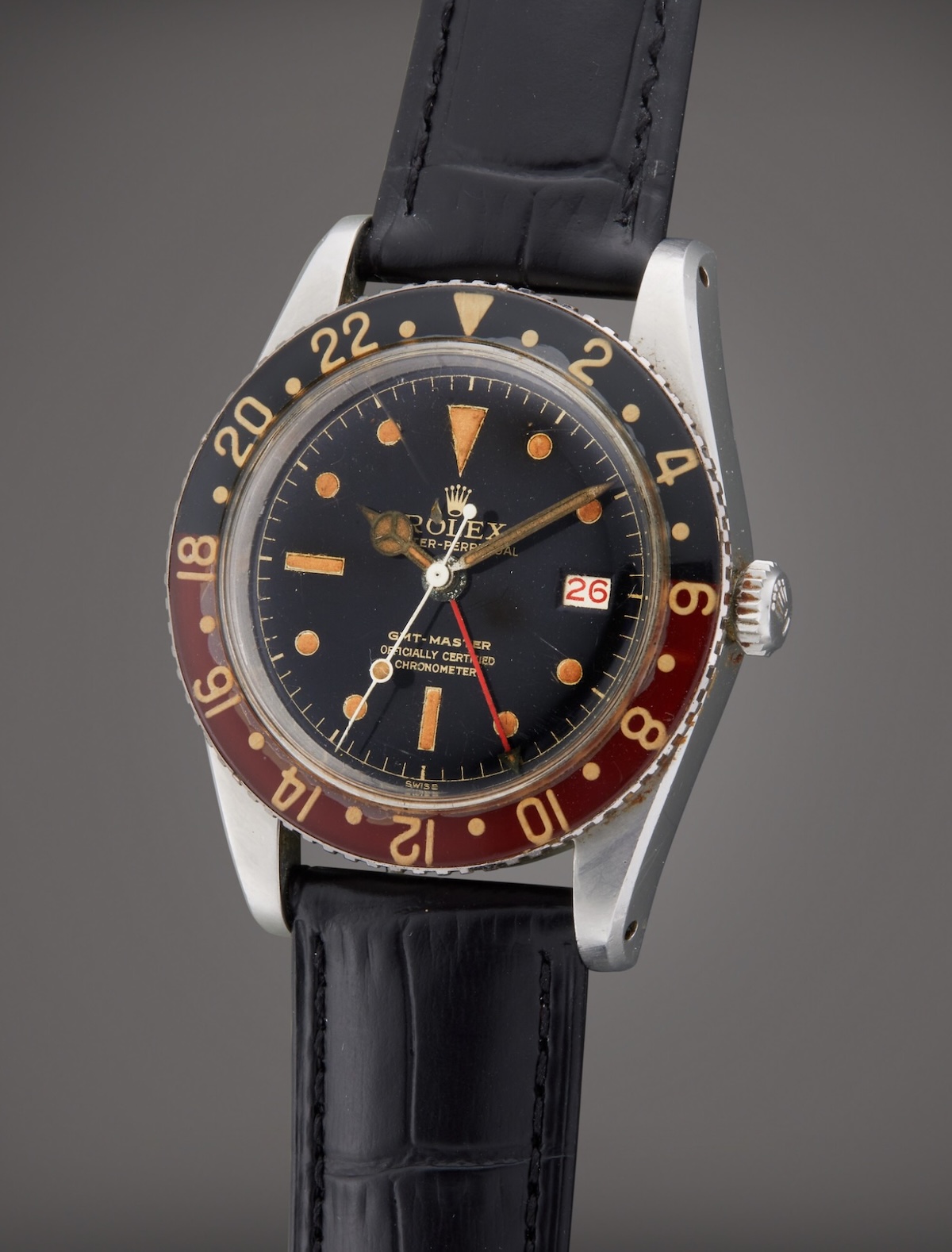
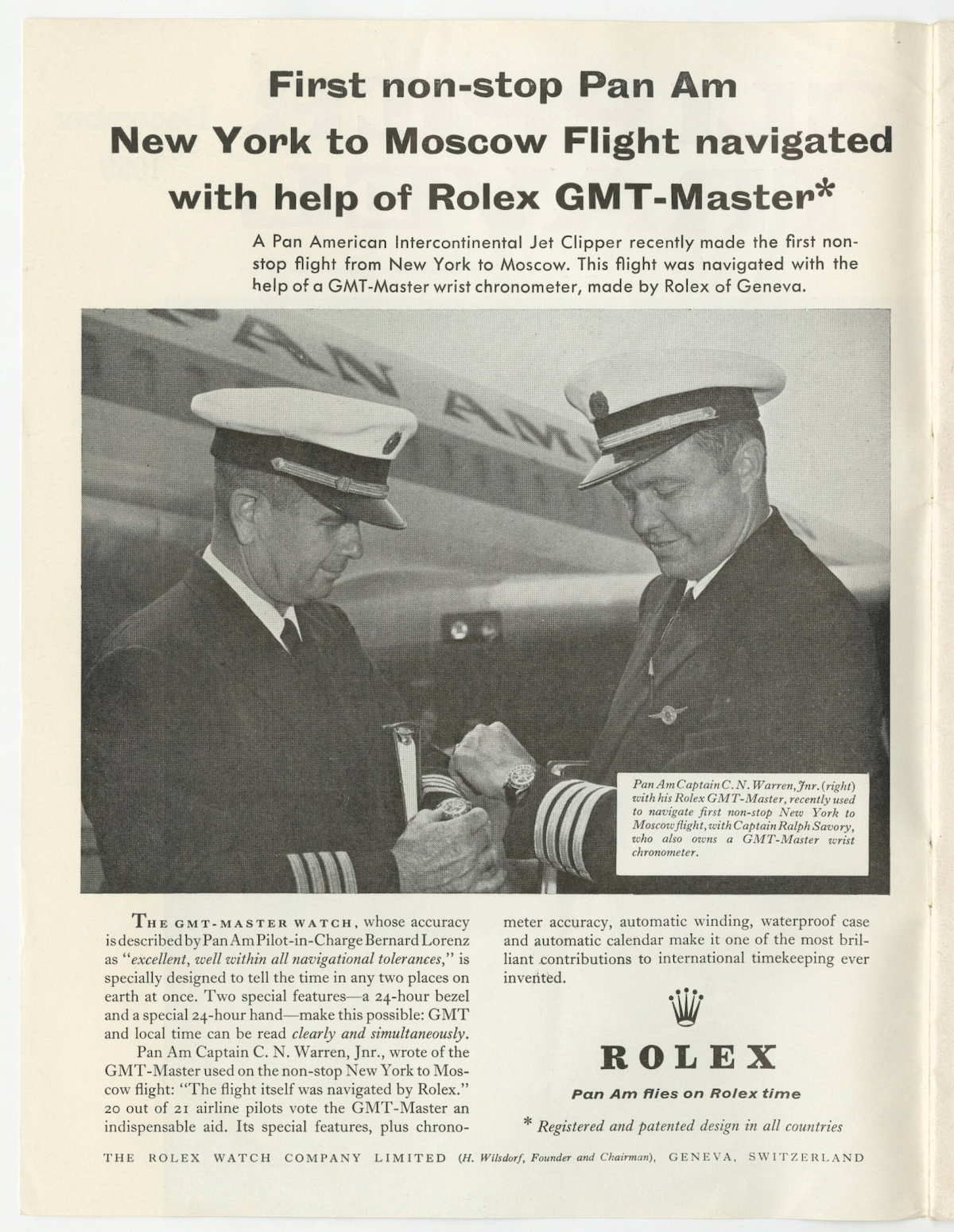

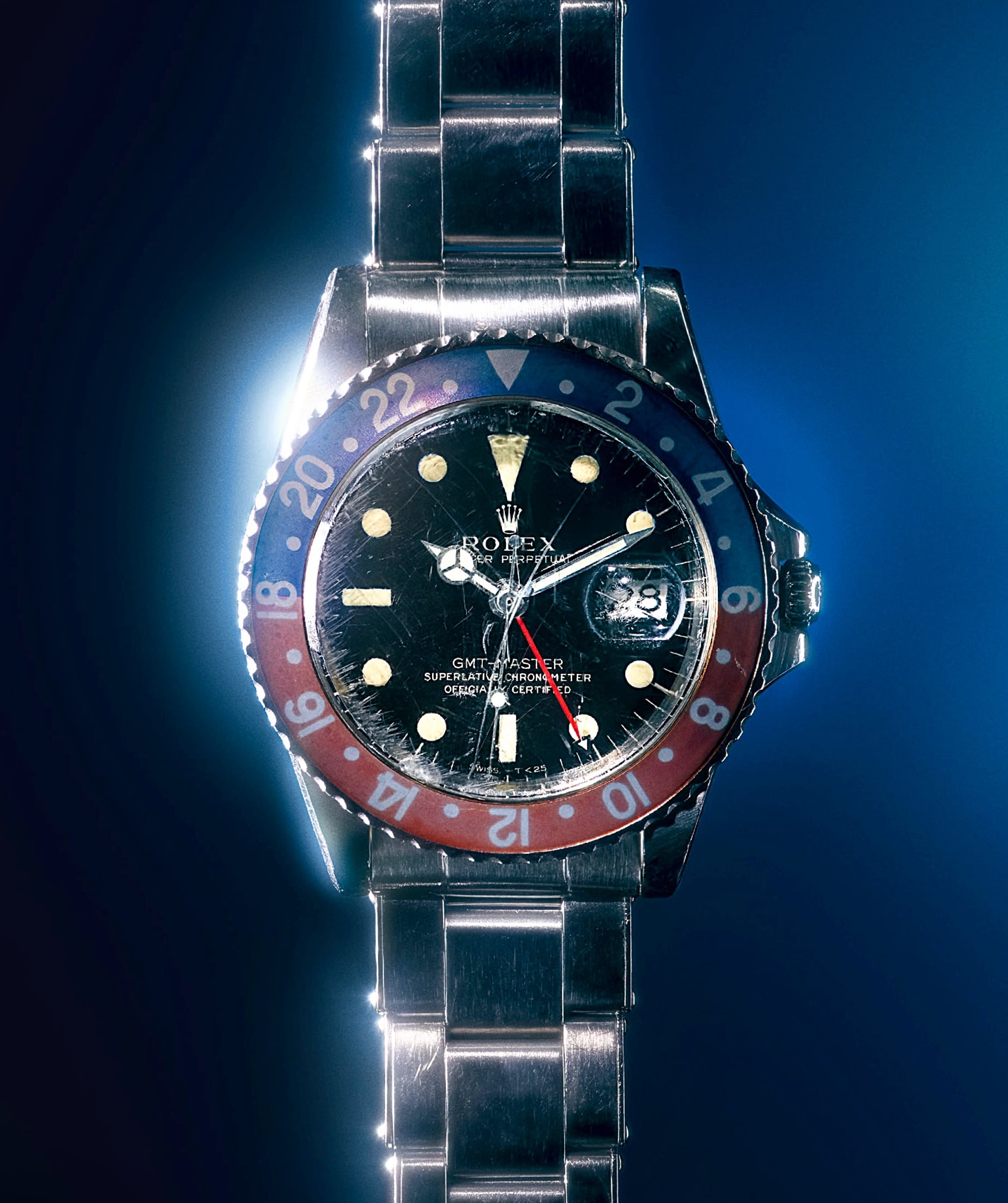
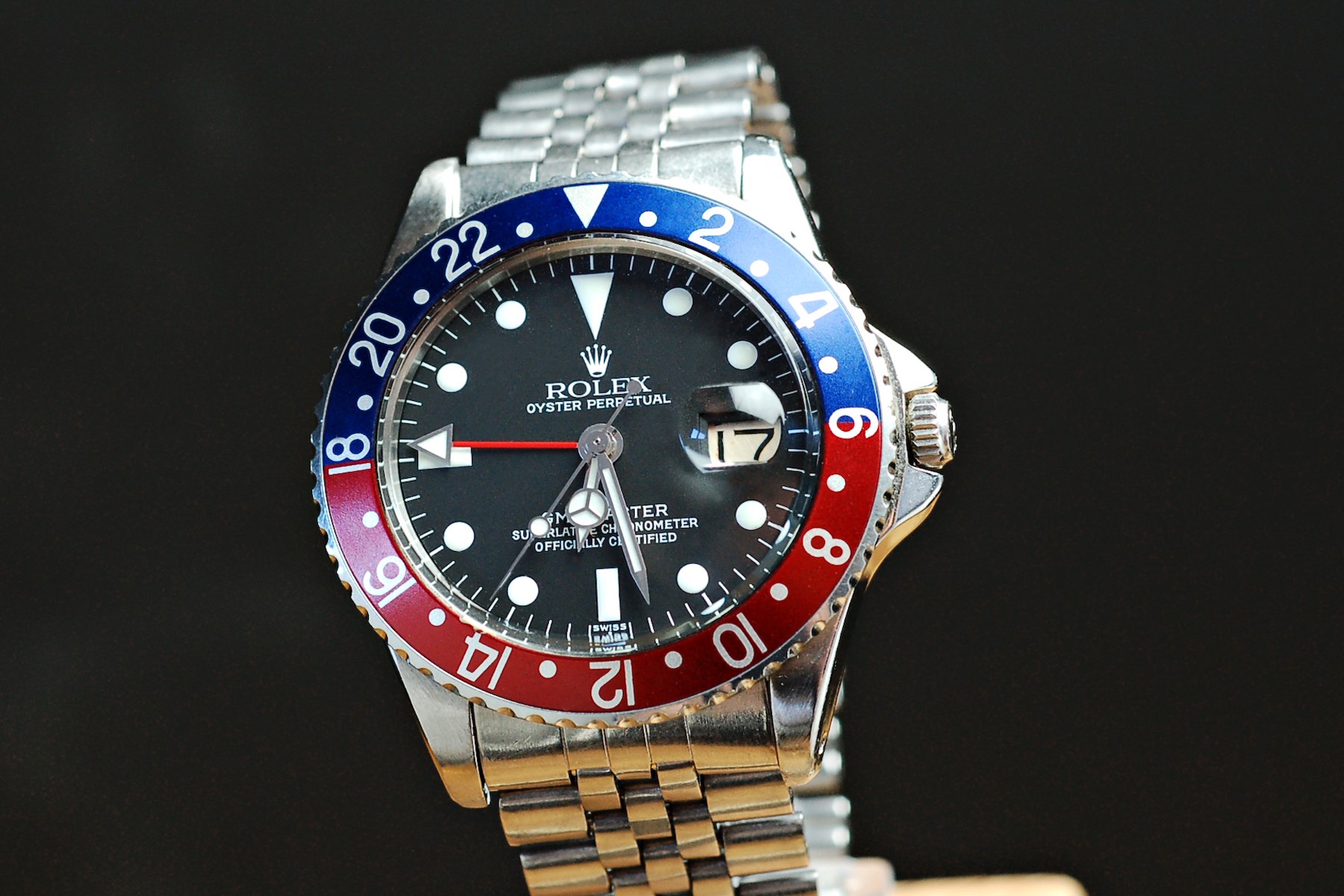
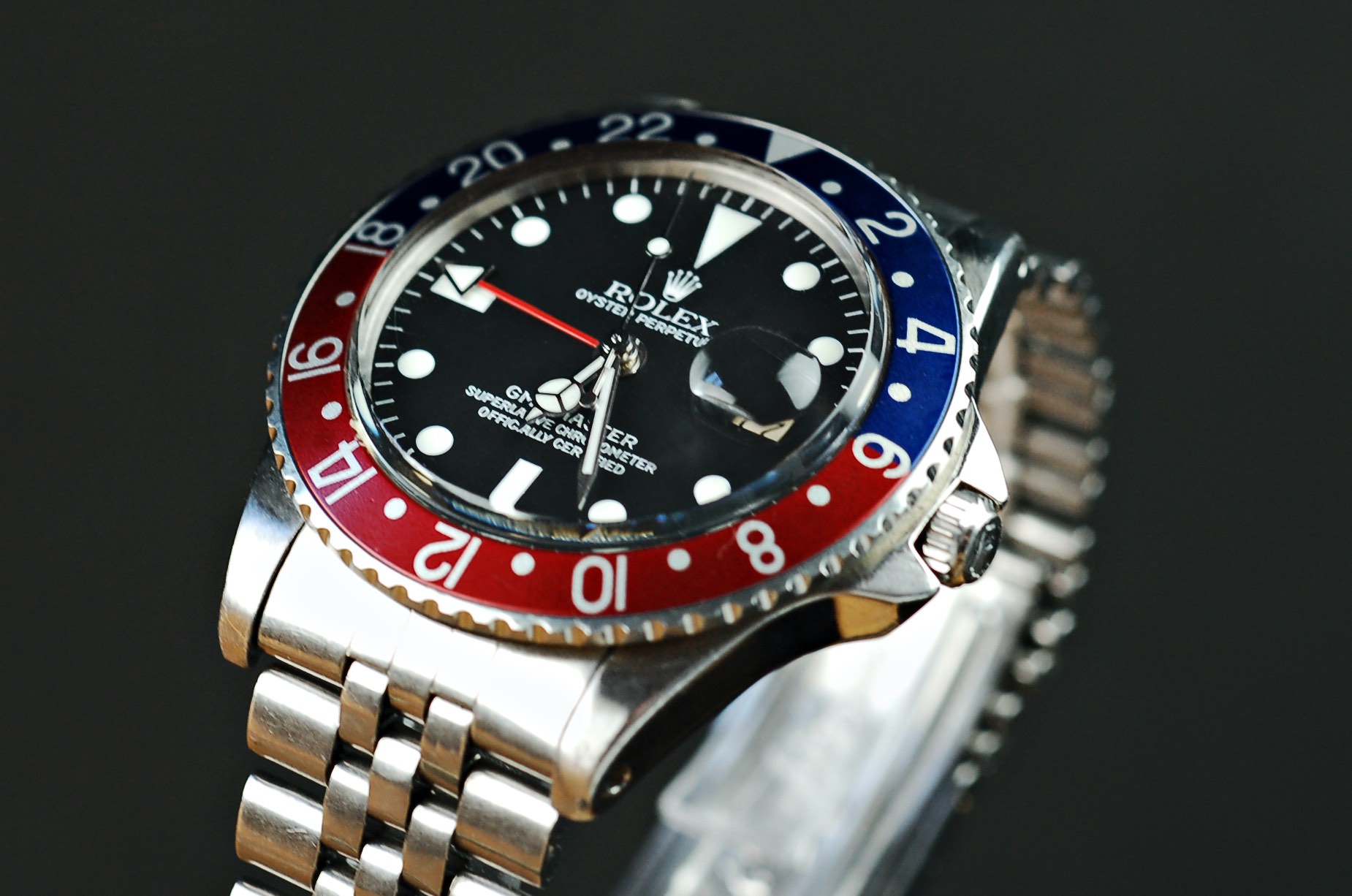
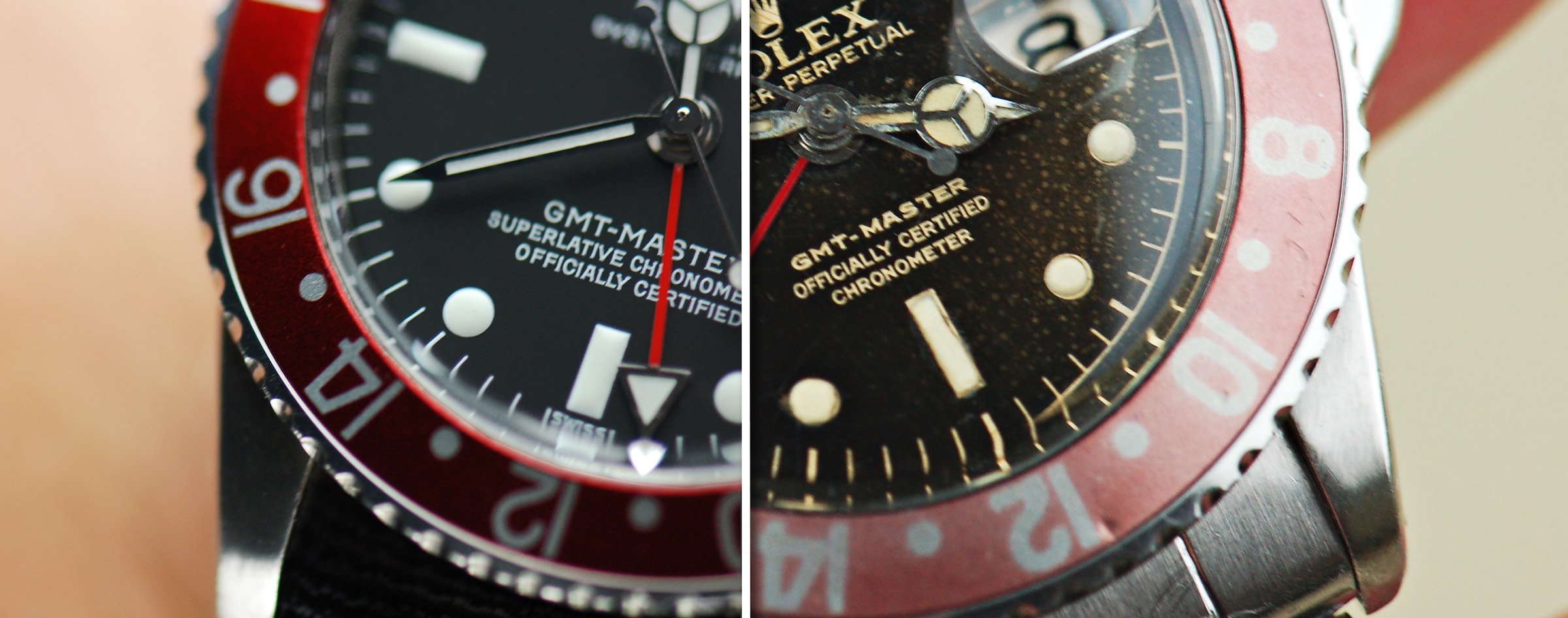
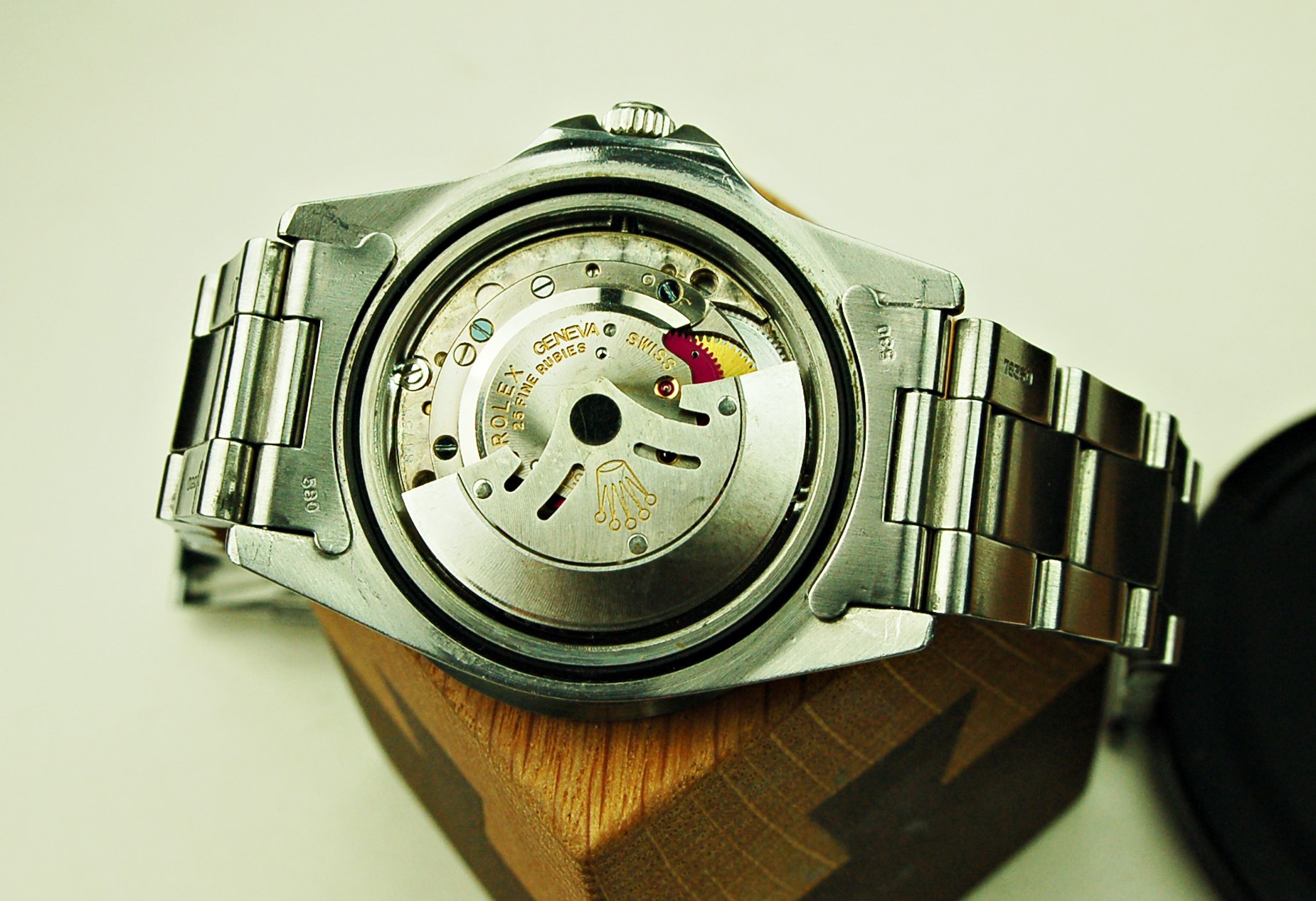
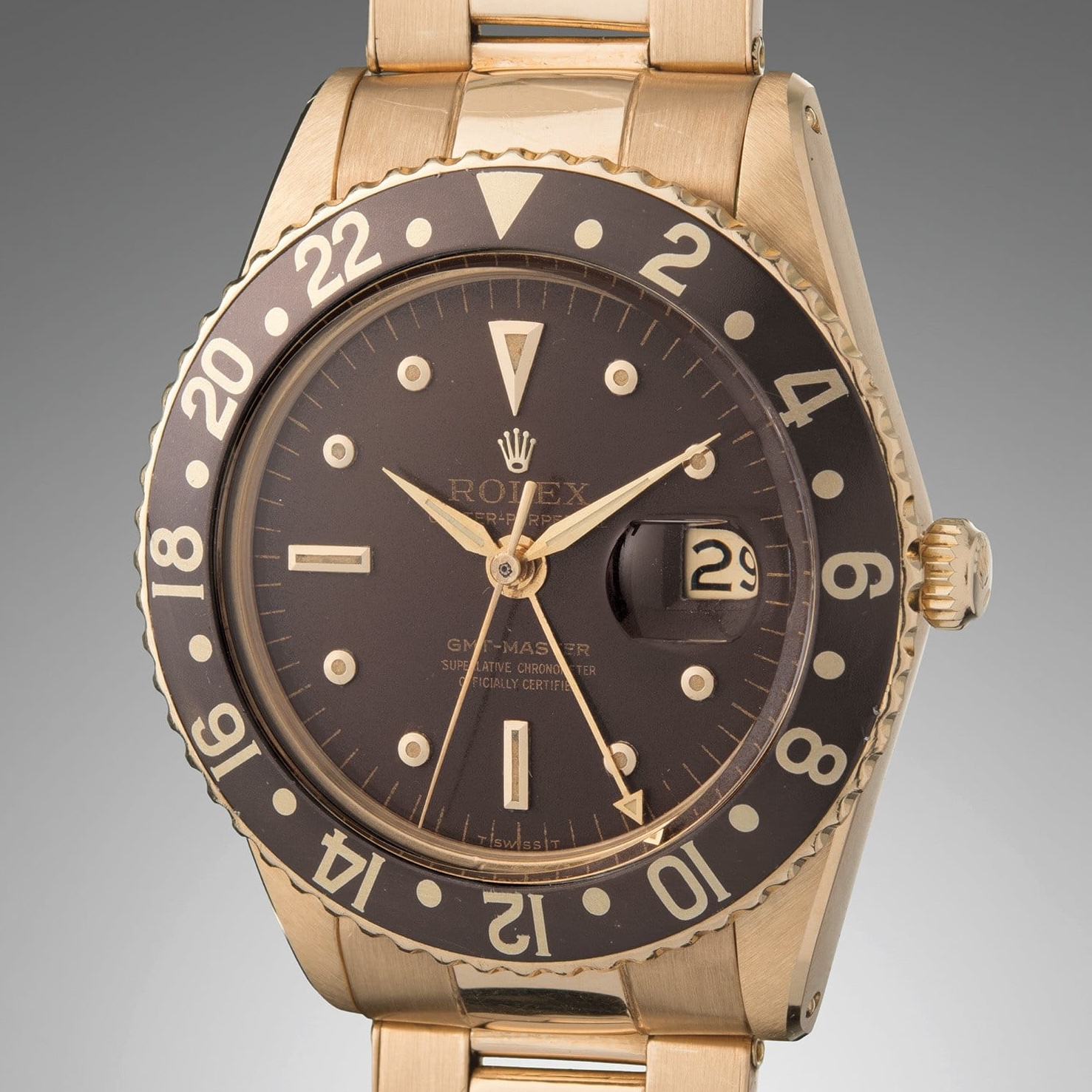
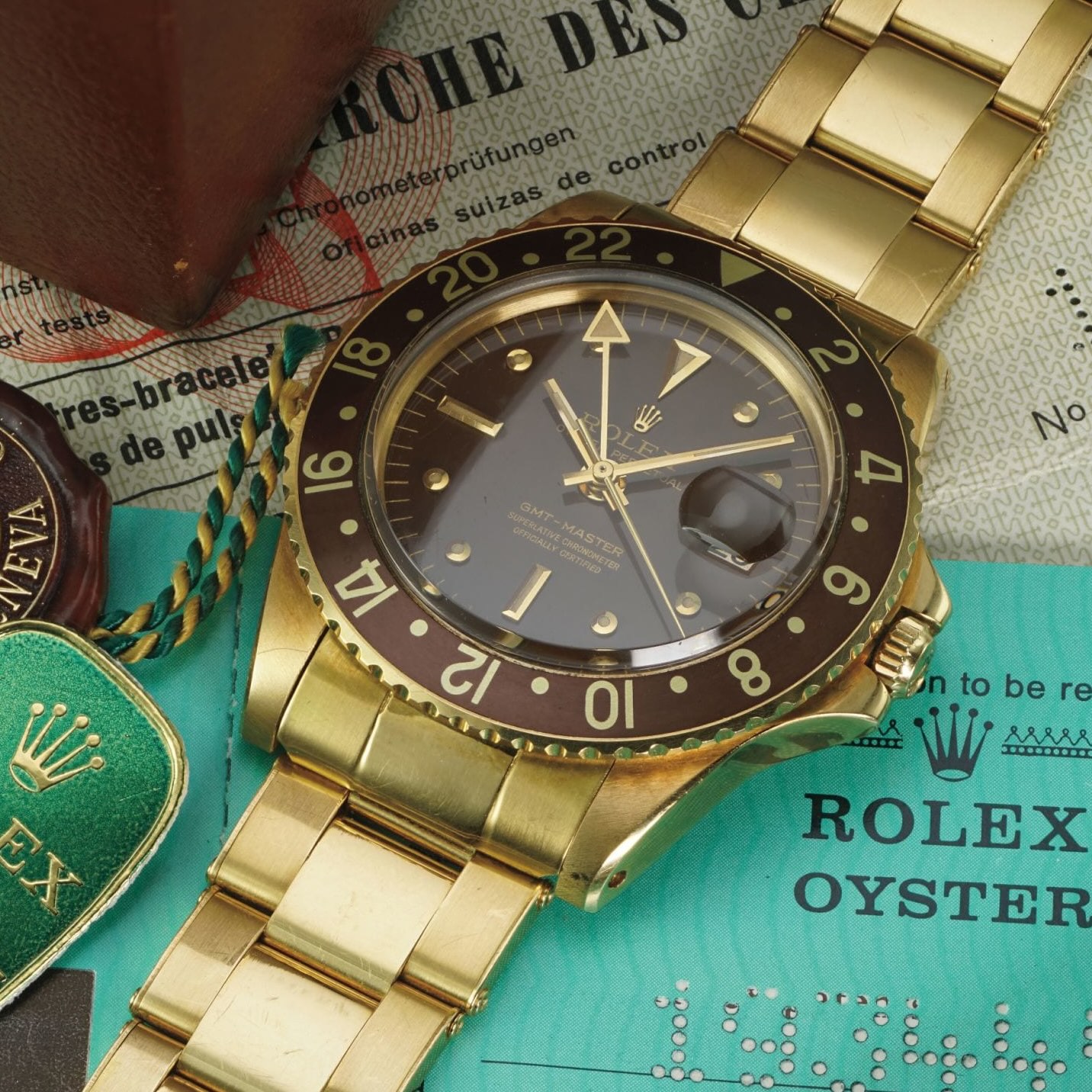
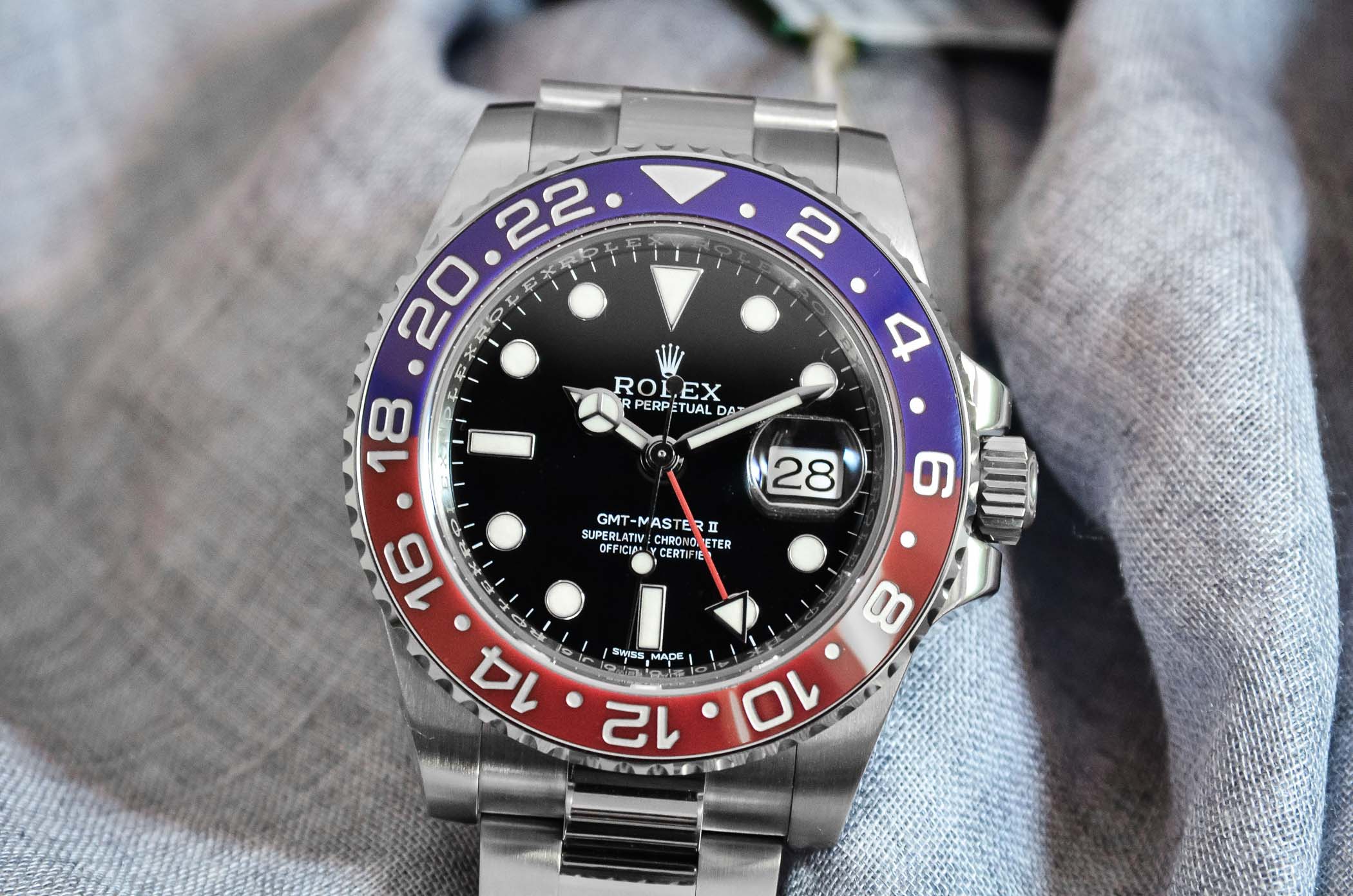
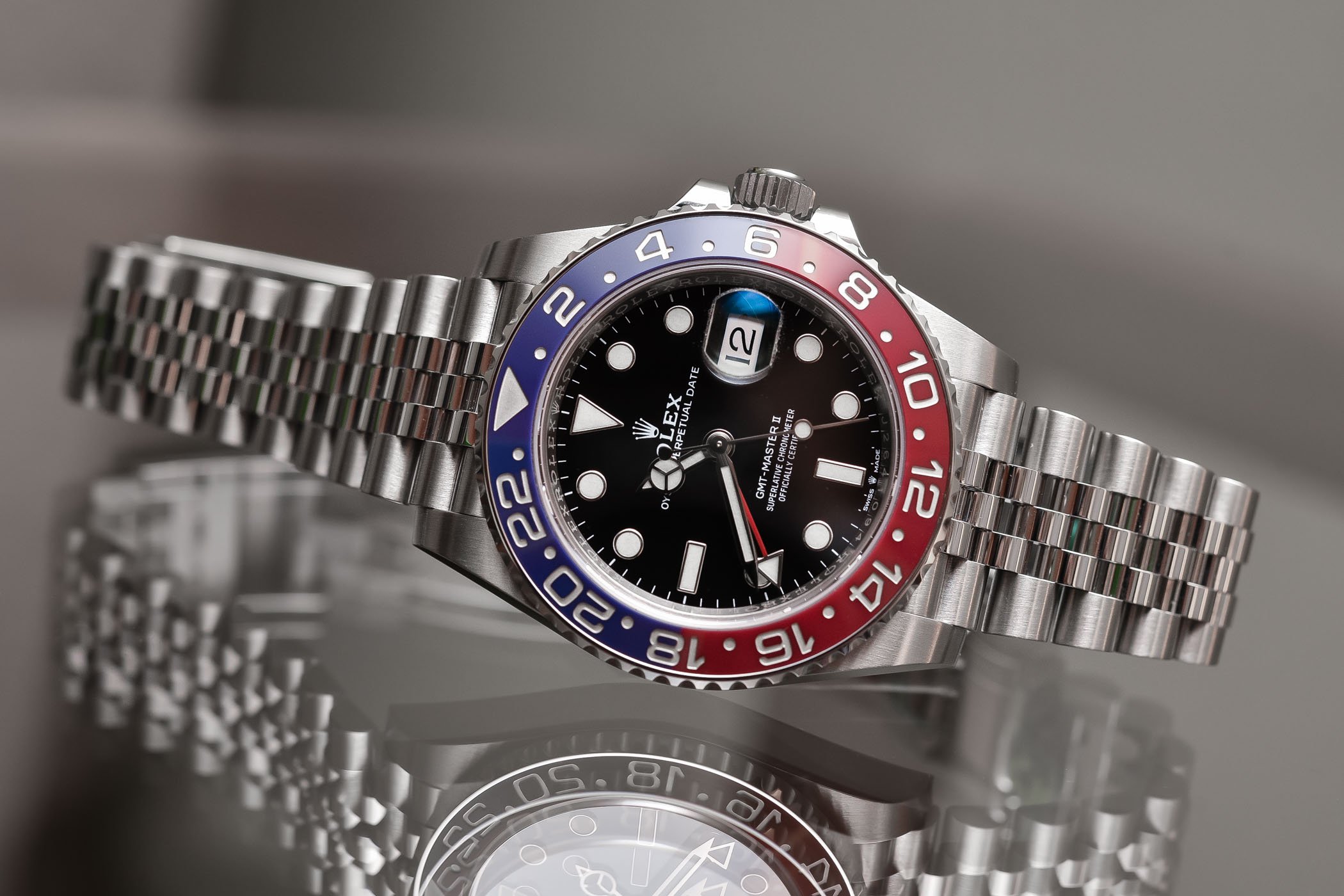
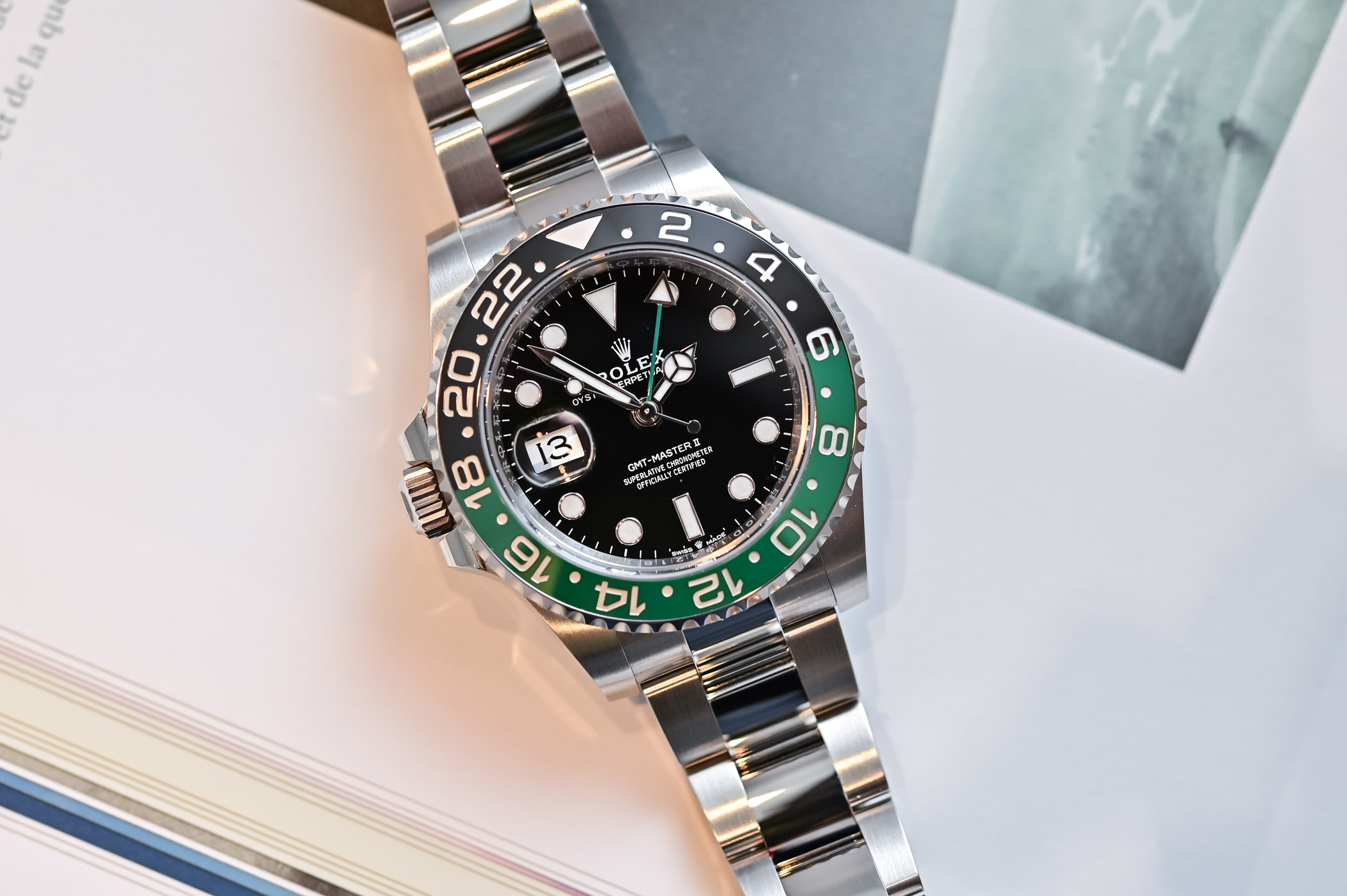



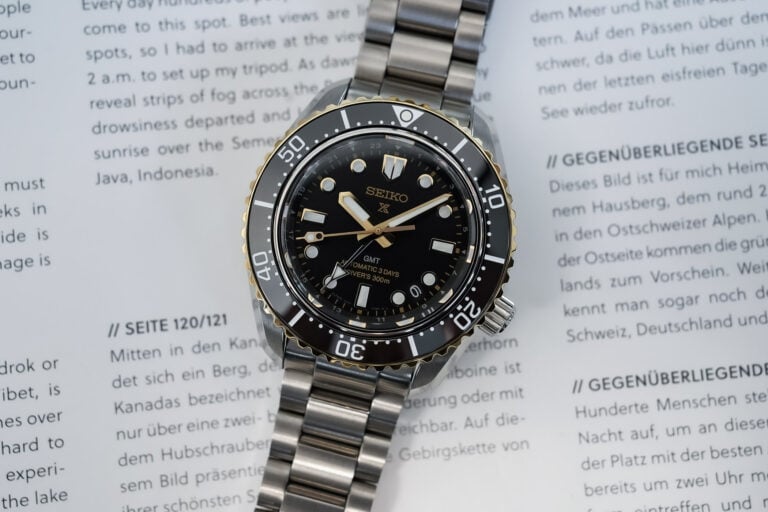
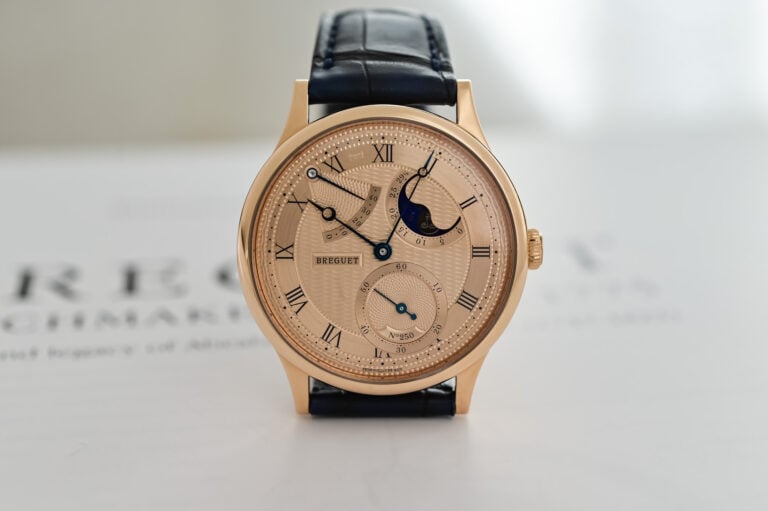
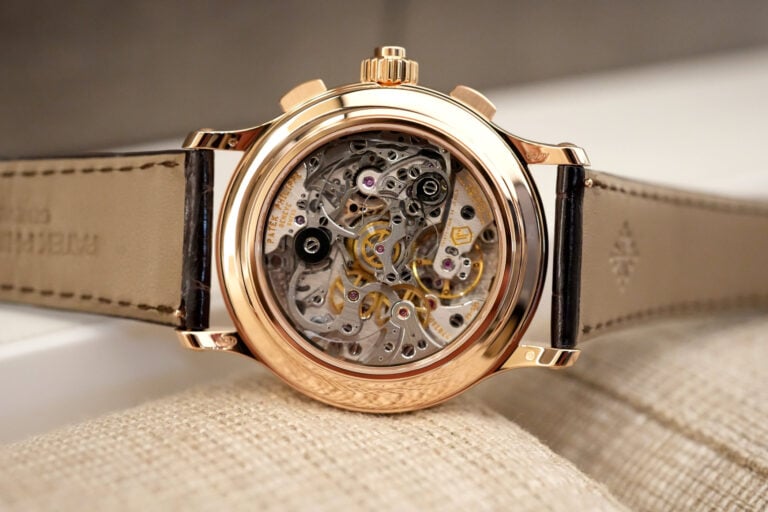
2 responses
Watches that mostly exist in photos
Mi padre tuvo un Rolex Oyster de los finales de los 50; lo compró nuevo cuando era joven; trabajaba en un banco en Curaçao.